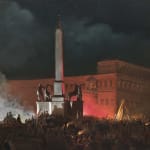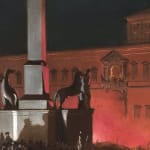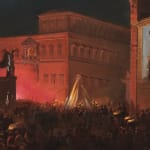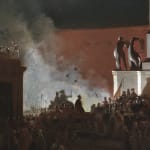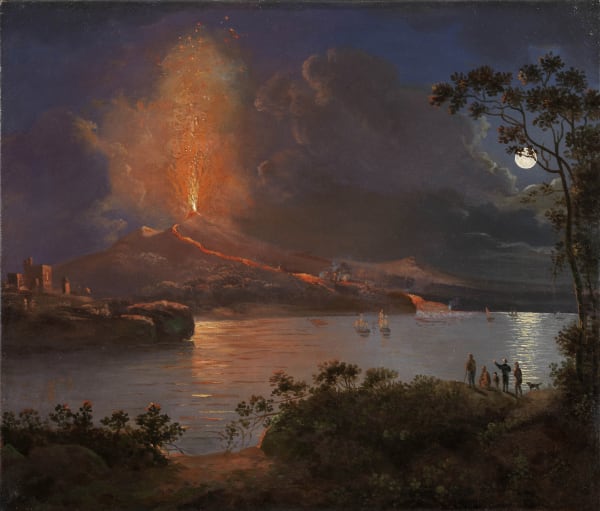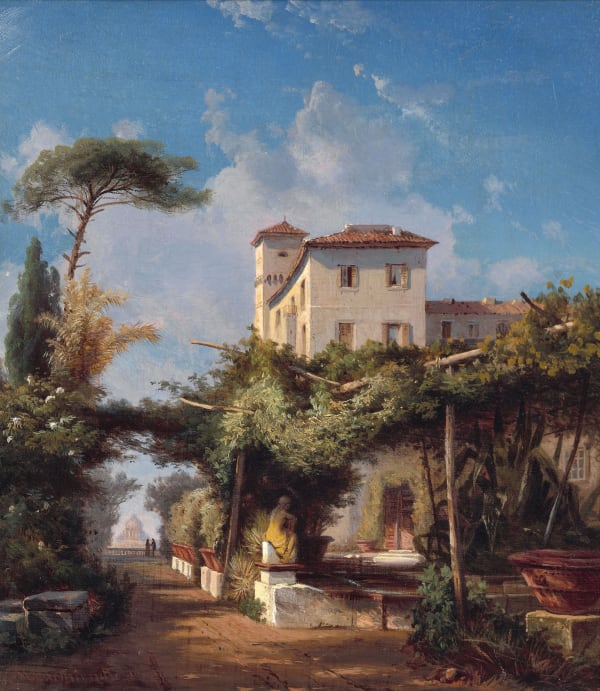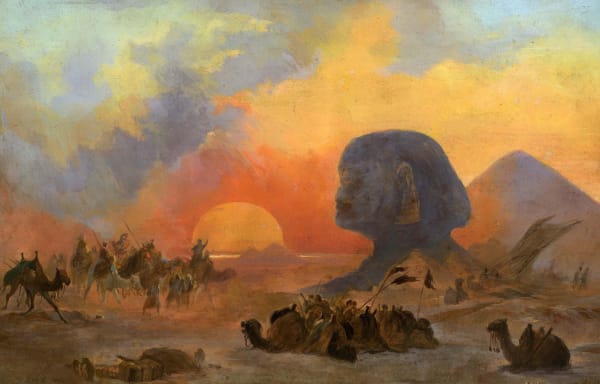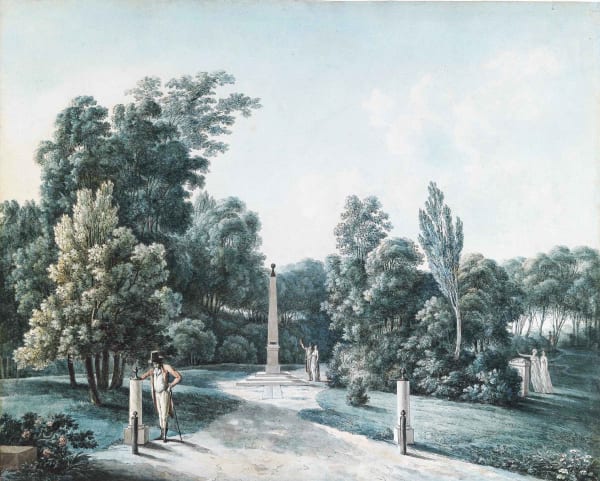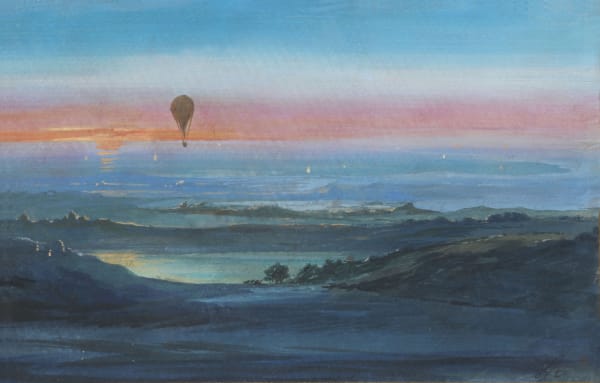
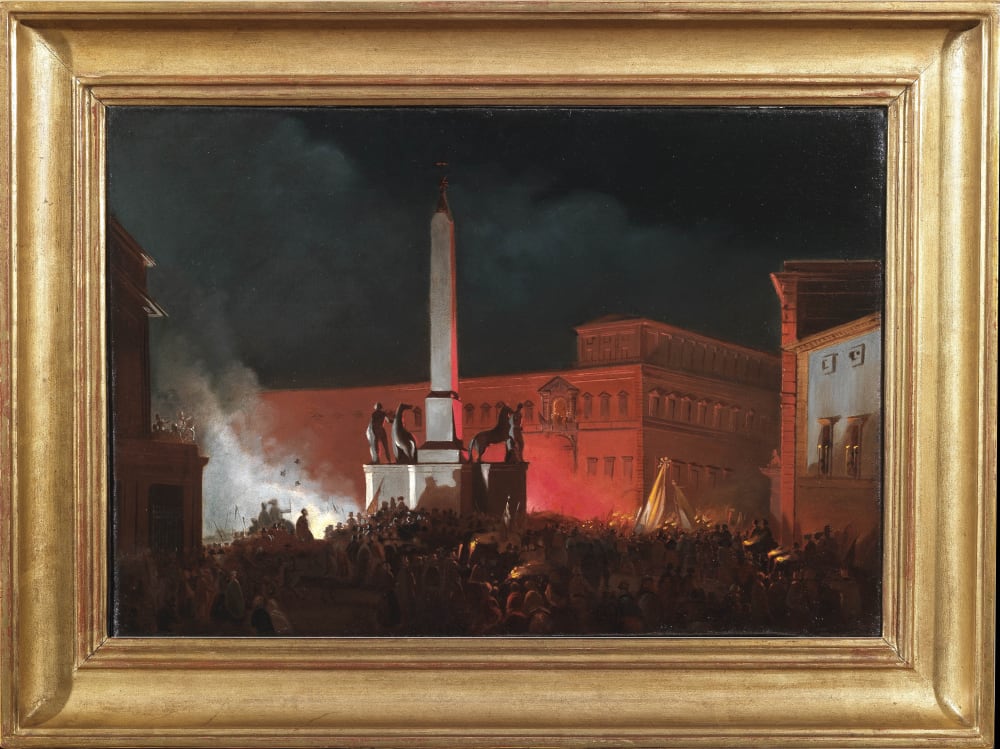




IPPOLITO CAFFI BELLUNO 1809-LISSA 1866
Further images
Provenance
Venice, Italico Brass Collection (1870 - 1943);
Milan, Private Collection.
Exhibitions
Le Peuple de Rome. Représentation et imaginaire de Napoleon à l’Unitè italienne, Ville d’Ajaccio, Palais Fesh, Musèe des Beaux-Arts, 28 Juin – 30 Septembre 2013, pag 196
Literature
G. Avon Caffi, Ippolito Caffi (1809–66), Padua 1967;
G. Capitelli, Mecenatismo pontificio e borbonico alla vigilia dell’Unità, with an entry by I. Sgarbozza, Rome 2011;
M. De Grassi, “Scrivettimi qualchuna cosa della nostra Patria”. Ippolito Caffi e Belluno nelle lettere ad Antonio Tessari, in Caffi. Luci del Mediterraneo, exhibition catalogue (Rome, Palazzo Braschi) edited by Annalisa Scarpa, Geneva – Milan 2005, pp 43–53;
Caffi. Luci del Mediterraneo, exhibition catalogue (Rome, Palazzo Braschi) edited by Annalisa Scarpa, Geneva – Milan 2005;
M.Pittaluga, Il pittore Ippolito Caffi, Vicenza 1971.
This small oil painting by Ippolito Caffi, a talented landscape painter from Belluno who worked in Rome on several occasions from 1834 to 1848 and then again after 1855, depicts the nocturnal benediction on 10 February 1848 that was one of the most intense displays of enthusiasm aroused in the Roman populace by Pope Pius IX’s first two years in office. On that memorable day, after promulgating freedom of the press and granting a pardon for all political crimes, Pope Pius Mastai Ferretti made a celebrated speech to the Roman people listing his government’s achievements, reminding them of their duty to prevent public disorder and their obligation to work for harmony, and ending his speech with the famous invocation: “Great God, bless Italy!” That same evening, in an overwhelming wave of enthusiasm, the crowd filled Piazza del Quirinale and the pope appeared on his balcony in secular company to impart a solemn blessing.
Despite being staunchly anticlerical, Caffi observed developments in Pope Pius’s early pontificate with benevolent interest, as indeed did most of the artists in Rome’s artistic community at the time (Capitelli 2011, pp. 20–22). Caffi’s correspondence with his friend Antonio Tessari reveals his support for the pope’s early actions: “Before, it was all despotism and tyranny; now the people are in charge, the law is properly administered and everyone can draw close to their shepherd!” (Belluno, Biblioteca Civica, ms 740; M. De Grassi 2005). A few weeks after the address to the people of Rome, after 24 March 1848 which was when Caffi left the city to move to Venice, prompted by a desire to play a personal role in the Risorgimento, he wrote to his friend that he had completed a painting entitled Popular Demonstration for Pius IX, that he had shown it in Venice, that he had sold it, that he was planning to produce it in a larger format and that he proposed to “repeat the same theme several times over”. The original model on card showing the first version of the painting (as yet untraced, though formerly in the Avon Caffi collection) is probably the one in the Museo Correr (Cl. I, 591) bearing the inscription “L’ultima dimostrazione fatta a Pio IX il 10 febbraio 1848” [“The last demonstration staged for Pius IX on 10 February 1848”]. The subject matter must have proven extremely popular because Caffi was commissioned to produce a number of different versions, all of the highest quality (Pittaluga 1971, p.58; A.Villari, entry X.1, in Rome 2003, Maestà di Roma, p.240; A. Scarpa, entries 51,52 and 53 in Rome 2006, Caffi. Luci del Mediterraneo, pp. XX; S. Arangio, entry 2, in Rome 2010, Il Risorgimento a colori, pp.111–12).
In the small painting under discussion here, Caffi focuses on the play of light caused by the torches and bonfires on the façades of the Palazzo del Quirinale and Palazzo della Consulta, and on the obelisk and the statues of Castor and Pollux, the symbolic centre of Romanitas. Crucial to the painting is the depiction of the festive populace waving their arms and hats aloft, while the metal flagpoles glimmer in the light cast by the flames. In this dreamlike vision resting on sharp chiaroscuro and a lively palette, Caffi provides us with a living yet poetic record of the Roman people’s sense of participation in politics, documenting their boisterous emotional involvement in a moment of particularly widespread support for the papacy, which was soon to be dashed by Pius IX’s subsequent actions and which was to lead to the brief but intense experiment known as the Roman Republic.
- Giovanna Capitelli
-
 ARTHUR BLASCHNIKView of Saint Peter from Villa Pamphili
ARTHUR BLASCHNIKView of Saint Peter from Villa Pamphili -
 Italian school, late 18th centuryVesuvius night eruption
Italian school, late 18th centuryVesuvius night eruption -
 GUIDO CADORINView of a Venetian festival
GUIDO CADORINView of a Venetian festival -
 JOHANN HERMANN CARMIENCKEView of Villa Malta with St. Peter’s Basilica in the Background, 1862
JOHANN HERMANN CARMIENCKEView of Villa Malta with St. Peter’s Basilica in the Background, 1862 -
 IPPOLITO CAFFICairo, the Simoun wind in the desert, 1843
IPPOLITO CAFFICairo, the Simoun wind in the desert, 1843 -
 JEAN-FRANÇOIS SABLETView of the solar obelisk at Villa Borghese
JEAN-FRANÇOIS SABLETView of the solar obelisk at Villa Borghese -
 ANSELMO BUCCIIl Colosseo quadrato, 1938
ANSELMO BUCCIIl Colosseo quadrato, 1938 -
 IPPOLITO CAFFIAscending over the Roman countryside in a hot air balloon (Lake of Albano), 1847
IPPOLITO CAFFIAscending over the Roman countryside in a hot air balloon (Lake of Albano), 1847
